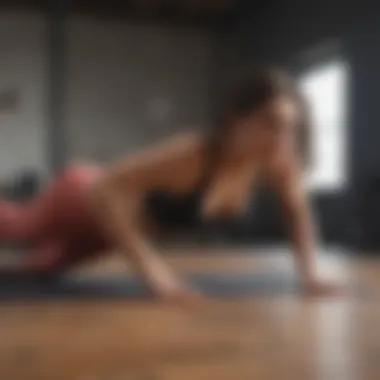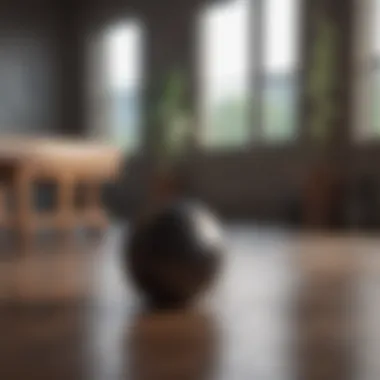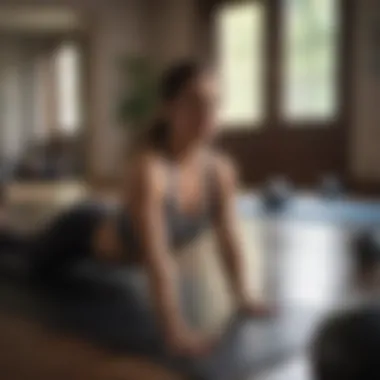Mastering Pilates: Essential Techniques and Benefits Unveiled


Intro
Pilates offers a unique blend of physical and mental benefits. This exercise method focuses on aligning the body and mind, promoting not just fitness but a holistic approach to well-being. It incorporates elements that cater to body strength, flexibility, and improved posture. These aspects are significant for any fitness regime, especially for those who wish to enhance their overall quality of life.
Well-Being Overview
Well-being is a multi-dimensional concept that encompasses not only physical health but emotional and mental stability. Focusing on well-being through Pilates can significantly improve one’s lifestyle.
Importance of Focusing on This Aspect of Well-Being
In today’s fast-paced world, neglecting one's well-being is common. Striking a balance between work, life, and personal care is essential. Pilates can aid in creating this balance. Exercise here is not just about the body, it’s about bringing peace to the mind. The regular practice strengthens muscles while clearing mental clutter, leading to enhanced endurance in daily tasks.
Mental Health Matters
Understanding Mental Health
Mental health plays a pivotal role in overall well-being. It can affect emotions, thoughts, and behavior. Pilates promotes relaxation and helps with deeper breathing, which aids in calming one’s mind. This happens mainly through controlled movements and rhythmic breathing.
Strategies to Improve Mental Well-Being
Several strategies can enhance mental well-being through Pilates:
- Mindful breathing alongside exercises
- Regular practice to develop consistency
- Utilizing controlled motions to focus the mind
Coping Mechanisms for Stress and Anxiety
It’s common to experience stress and anxiety. Pilates offers coping mechanisms through physical activity and focus. Engaging in this practice systematically redirects attention from stressors, fostering a sense of control.
Physical Wellness
Exercise Routines and Tips
When beginning Pilates, start with basic exercises to develop core strength. Familiar poses are:
- The Hundred
- Roll-Up
- Leg Circles
Consistent practice amplifies benefits, enhancing one’s physical capabilities.
Healthy Eating Habits
Nutrition complements the body’s fitness. Adopting healthy eating habits is key. Focus on nutrient-dense foods to support Pilates practice, like:
- Leafy greens
- Lean proteins
- Whole grains
Importance of Regular Physical Activity
Regular physical activity has undeniable benefits. It improves cardiovascular health, strengthens muscles, and contributes to mental clarity. Engaging in weekly Pilates sessions facilitates retention of these benefits, compelling all aspects of wellness to flourish.
Mindfulness & Self-Care Practices
Exploring Mindfulness Techniques
Techniques like meditation during warm-ups are valuable. It's essential to sync mind and body.
Self-Care Rituals for Rejuvenation
Post-Pilates, integrating self-care rituals aids recovery. These can include stretching or taking a short meditation.
Balancing Work and Relaxation
Finding time to relax contributes significantly to well-being. Prioritize Pilates sessions to ease work-induced tension, alleviating stress quickly and effectively.
Nutrition for Nourishment
Benefits of a Balanced Diet


A balanced diet greatly contributes to one’s capacity for exercise. Energy levels improve significantly through nutrition and physical activity.
Nutrient-Rich Food Recommendations
Foods naturally rich in nutrients aid in maintaining energy and focus throughout the day:
- Nuts and seeds
- Berries
- Herbs and spices
Easy and Healthy Recipes to Try
Experimenting with recipes incorporating these foods can add value to one’s diet while maintaining engagement in healthy eating practices.
“Time spent in self-improvement and care directly nonly helps personal effectiveness but enhances relationships around you.”
Understanding Pilates
Understanding Pilates is a critical foundation for anyone looking to engage effectively with this form of exercise. Comprehending the origins, core principles, and benefits of Pilates allows practitioners to appreciate how these elements contribute to a well-rounded fitness strategy.
Pilates is more than just a physical workout; it encompasses training of the mind and body, promoting overall well-being. This section will elucidate important aspects you should know, ensuring that participants grasp what makes Pilates a valuable addition to any exercise regime.
History of Pilates
Pilates was developed by Joseph Pilates in the early 20th century. Originally named Contrology, this discipline merges physical training with mindfulness and mental control. After relocating to the United States from Germany, Pilates began to evolve his techniques.
He aimed to create a system nurturing not just improved physical health but also mental resilience. Many individuals used Pilates for rehabilitation post-World War I, a practice that further showcased its benefits. Understanding the historical context of Pilates reveals the system's foundational belief in the body's capability to heal and strengthen.
Principles of Pilates
At the heart of Pilates are several core principles that inform every exercise and movement. These principles include:
- Concentration: Engaging the mind fully in each exercise.
- Control: Ensuring that all movements are intentional and precise.
- Centering: Understanding the importance of the core as the body’s powerhouse.
- Flow: Moving with grace and fluidity to enhance performance.
- Precision: Each element of the exercise must be executed correctly for maximal benefit.
- Breathing: Proper breathing techniques are essential for achieving the best results and promoting relaxation.
These principles provide structure to Pilates practice, allowing individuals to achieve stability, strength, and flexibility in a balanced manner.
Benefits of Pilates
Participants can garner numerous physical and mental benefits from practicing Pilates. Notable advantages include:
- Improved core strength: Central to Pilates, core engagement across various movements enhances stability and support.
- Enhanced flexibility: Regular practice fosters greater flexibility through controlled movements that stretch and elongate muscles.
- Posture improvements: Pilates focuses heavily on posture and alignment, driving awareness that translates into better daily movements.
- Injury prevention: Mindful movements and strength-building routines can help alleviate the risk of injuries.
- Better body awareness: Practitioners develop a profound understanding of how their bodies move.
- Stress relief: Mindfulness entailed in the practice encourages relaxation while also reducing anxiety.
One of the key factors in the success of a Pilates regimen is the focus on breathing. Engaging in proper and mindful breathing can significantly enhance both the practitioner’s performance and mental clarity.
Establishing a thorough understanding of these elements enables individuals to appreciate the depth of Pilates. Therefore, you'll be better positioned to affect positive changes in health and fitness by integrating these practices into a routine.
Getting Started with Pilates
Getting started with Pilates is a crucial step for individuals keen on enhancing their physical well-being. This section outlines what Pilates entails, the equipment needed, and terminology you will encounter. Understanding these fundamentals fosters a better practice and ensures safety and effectiveness during workouts.
What You Need for Pilates
Before you begin your Pilates journey, it is essential to gather the necessary equipment. Not all practices require extensive gear, but having a few key items can significantly enhance your experience.
- Mats: A good quality mat provides cushioning for the spine while performing exercises. Look for options that are non-slip to remain stable during your routine.
- Props: Items like Resistance Bands and Foam Rollers are beneficial. They assist in variety and flexibility of practice while improving muscular engagement.
- Comfortable Clothes: Special training attire is not required. However, wearing fitted clothing can help to monitor your body’s posture and alignment.
Pilates studios can be equipped with machines like Reformers which add resistance. If available, try these machines under guidance for a different experience.
Basic Terminology in Pilates
When engaging in Pilates exercises, familiarizing yourself with vital terms enhances understanding and communication. Here are some terms you may encounter:
- Core: Refers to the muscles surrounding the abdomen, lower back, and pelvis. A strong core is essential for nearly all movements in Pilates.
- Alignment: This concept is about positioning your body correctly during exercises to avoid injury and enhance effectiveness.
- Movement Patterns: Refers to the specific sequences of muscle engagements and body positioning throughout a routine.
Knowing these terms helps you grasp the nature of Pilates practices while making sessions more productive. The vocabulary is straightforward and aids in following instructions in group settings too.
Finding the Right Instructor
Choosing the correct instructor can greatly influence your Pilates experience. Their expertise shapes not only your technique but also your enthusiasm for the practice.


- Qualifications: Ensure that the instructor has relevant certifications. Various organizations offer proper training in Pilates methods; check prior to joining a class.
- Teaching Style: Different instructors have unique styles. Some may emphasize technique while others might foster a friendly, informal setting. Attending trial classes helps in assessing compatibility.
- Focus on Individual Needs: An adept instructor should consider various fitness levels and potential limitations. You should feel comfortable expressing your goals with them.
Finding the right instructor aligns with achieving effective results seekers may desire from Pilates practice. Take time to identify who best complements your personal fitness journey.
Selecting an instructor is as vital as the practice itself. A knowledgeable guide can enhance your overall experience and contribute significantly towards your improvements in technique and well-being.
Essential Pilates Exercises
Understanding the core exercises in Pilates is crucial for anyone looking to explore this unique practice. Pilates exercises not only emphasize the importance of controlled movements but also prioritize the alignment and connection between the body and mind. Integrating these essential movements into a fitness routine can significantly enhance strength, flexibility, and postural alignment, while also addressing specific fitness goals. These exercises establish stamina and coordination, laying the groundwork for progressive development within the method.
Beginner Exercises
Starting with beginner exercises forms a foundational understanding of Pilates. These moves emphasize controlled, precise movement, often involving minimal resistance. For newcomers, the focus should be on form and breathing, rather than complexity. Recommended beginner exercises include:
- The Hundred: Laying on your back with legs lifted to a tabletop position, pump your arms as you inhale for five counts and exhale for five counts. This strengthens the core while improving circulation.
- Single Leg Stretch: Lying on your back with your legs in tabletop, bring one knee to your chest while extending the other leg. Alternate legs while maintaining low back support. This stretches the hips and activates the core.
- Roll Up: Begin lying flat on your back. Engage your core and slowly roll up to a seated position, gradually reaching towards your toes before rolling back down. It improves flexibility in the spine and abdominal strength.
These beginner exercises prepare the practitioner for more complex tasks as they gain strength and comprehension.
Intermediate Exercises
Once foundational skills are built, moving onto intermediate exercises allows for enhanced challenge and better mastery of technique. These exercises introduce varied challenges by adding resistance or requiring greater balance. The emphasis remains on maintaining proper alignment through all movements. Valid choices here include:
- Swan Dive: Positioned on your stomach, lift the chest, extend the arms forward, and simultaneously raise the legs. This opens the chest while strengthening the back muscles.
- Double Leg Stretch: Starting on your back with legs in tabletop, extend both arms and legs together away from your center, and back to the starting position. This promotes better core stability and alignment.
- Side Leg Series: Laying on one side, raise the top leg flexibly while keeping the body in a straight line. This strengthens the lateral leg muscles and creates greater hip stability.
Mastery of intermediate exercises solidifies core skills as practitioners prepare for more advanced techniques.
Advanced Exercises
Advanced exercises in Pilates exhibit the highest level of control, power, and integration across the body. The movements often combine multiple skills and require a strong connection between breath and movement.
- Teaser: Starting from a seated position with legs extended, roll back, balancing on your sit bones and legs lifted. Reach towards the feet and hold balance. This trains the core effectively while enhancing coordination.
- Leg Pull Front: In a plank position, lifting one leg up while keeping the core engaged and neutral spine. Alternate legs in a controlled manner to strengthen the entire torso and hip muscles.
- Snake/Twist: From a side plank, bring the top arm up, twisting your body while maintaining alignment. This enhances full-body strength and flexibility.
These advanced moves, albeit challenging, complete the Pilates journey by showcasing true body control and strength.
Mastery of these exercises helps cultivate a strong core, resilience, and the physical adaptability necessary for maintaining longevity in fitness.
Incorporating these essential Pilates exercises into a routine enriches not only physical capability but connects you to a community eyeing mindful physical health. Practitioners can seamlessly transition through grave phases of skill, fostering considerable improvements along the way. By understanding the gradation in the exercises, any individual can effectively engage with Pilates at the level that suits them.
Pilates Techniques and Tips
Mastering Pilates is not just about the exercises; it is equally important to understand the techniques and tips that help maximize their effectiveness. These insights can improve alignment, enhance breathing, and potentially prevent injuries. Whether you are a beginner or an experienced practitioner, knowing these elements can significantly change your practice. Let's explore each aspect in depth.
Proper Alignment in Pilates
Proper alignment is essential in Pilates. It ensures that each movement is gym for correct muscle engagement. Staying in right alignment reduces joint stress and improves overall function of the body. Misalignment can quickly lead to straints or dminution of effectiveness. Key points about focusing on alignment include:
- Head and Neck: Ensure your head is in line with your spine. Avoid tilting or forward head position to ease neck strain.
- Shoulders: Keep shoulders down and back, not hunched or tense. This allows for better shoulder engagement and stability.
- Pelvic Position: Awareness of your pelvis is crucial. Anterior or posterior tilt can influence the effectiveness of core engagement.
Your instructor can help correct any misalignment, but maintaining focus on your own body during practice is equally important. This self-awareness mitiagates habits that can team with difficulty over time.
Breathing Techniques
Control over your breath is fundamental in Pilates. Breath work prepares the body for increasing body awareness and improves it. Effective delivery helps flow between exercises, supporting muscle movements seamlessly. The basic breathing technique to follow involves:
- Inhale through your nose: This helps expand the diaphragm fully, bringing oxygen to the body.
- Exhale through your mouth: Engaging your core muscles, it allows for a full release and assists in transitioning to the next movement.
- Inhale for engagement: Use the inhale to prepare for the move. It expands low ribs, creating space to refine positions and focus musculature.
By integrating proper breathing, you sustain umph to work efficiently and to navigate complicated poses. Especially during challenging movements, remember to breathe despite the temptation to hold your breath.
Common Mistakes to Avoid
Navigating Pilates can become tricky, as many practitioners fall prey to a few standard pitfalls. Being aware is key and can save much hassle for both new practitioners and seasoned goers. some of the commonoversights to pay attention to in practice include:
- Overarcing the Back: This often happens when engaging, leading to lumbar store, rather than activating the core.
- Poor Form in Exercises: Misalignments may cause undue stress to joints. This can hinder benefits and lead to nuances. Focus on quality rather than quantity.
- Holding Breath: Such a posture is not only dangerous but restricts the gins from correct flow.
- Neglecting Modified Exercises: Many temporary conditions may require variations that fit best for the person's current situation. Sticking too close to advanced movements can wreak havoc onwards.
Recognizing these mistakes enhances performance and fosters more fruitful sessions. It is through this knowledge that studios tailor personal journeys and refine methods uniquely established for clients' neurological systems. Being keen doesn’t just improve your perception but aids curating personal experiences beautifully tuned to confront unique aims.
Pro Tip: Document your sessions! Noticing improvements over time is encouraging while identifying frequent non-alignment aide mes will demonstrate paths where attentiveness needs emphasis.


Integrating Pilates into Your Routine
Integrating Pilates into your routine is a critical aspect of reaping its many benefits. It requires thought and planning but results in significant improvements in strength, flexibility, and core stability. As you incorporate Pilates into your fitness framework, it is essential to strike a balance with other exercises and activities you enjoy. This integration fosters a holistic approach to wellness and enhances overall physical capabilities.
Creating a Pilates Schedule
Developing a consistent Pilates schedule is necessary for novices and those experienced with exercise. Selecting specific days and times you commit to practicing Pilates will help reinforce the habit. Aim to perform Pilates at least two to three times a week for optimal results.
Consider the following tips when creating your schedule:
- Set Reminders: Use phone apps or calendars to set reminders, ensuring Pilates practice is part of your day.
- Vary the Routine: Incorporate different exercises and techniques weekly to keep cognitive engagement alive and avoid complacency.
- Adjust with Flexibility: Understand that life can be unpredictable. If you miss a predetermined session, rescheduling it without guilt is important.
By thoughtfully constructing your Pilates schedule, you lay momentum for steady progress.
Complementary Exercises to Pilates
To further enhance your Pilates practice, consider supplements that provide increased strength or cardio benefits. Complement include exercises that work on different areas or fitness levels such as:
- Yoga: Integrating mindfulness through yoga can promote flexibility and reduce stress.
- Strength Training: Incorporate exercises such as weightlifting to target specific muscle groups not focused on in Pilates.
- Cardiovascular Workouts: Aerobics, running, or swimming can elevate heart rate and improve stamina needed for Pilates.
Combining these of these activities will help create a well-rounded fitness regime.
Tracking Your Progress
Tracking your progress adds an extra layer of accountability. Various method of progress can focus on strength, flexibility, or consistency based outcomes. Here are some strategies:
- Journal Entries: Maintain a fitness journal to record workouts and snippets on how you felt after each session.
- Photographic Evidence: Take progression photos to visualize body changes over time.
- Set Goals: Consider smart goals, such as achieving certain poses or forms with correct alignment or improving flexibility in specific movements.
Utilize these documentation strategies to recognize improvements in your Pilates fitness persuit and adjustments needed if progress stalls.
“Tracking your journey is as important as practice itself; it not only motivates but provides insight into your evolving strength and capabilities.”
Addressing Common Concerns
Addressing common concerns regarding Pilates can guide potential practitioners toward safer and more effective practice. This section emphasizes important aspects that influence the inclusivity and accessibility of Pilates exercises. By discussing these matters, we can empower individuals who may have hesitations, increasing their motivation to engage and experience the benefits of Pilates exercises.
Pilates for Injury Rehabilitation
Pilates can actively contribte to injury rehabilitation. The focus of this method is on core stabilization, muscle control, and flexibility, essential elements for individuals recovering from injury. Practicing Pilates favors low-impact movements, allowing gentle yet effective exercise that helps facilitates recovery without straining the body.
In Pilates, it is vital to work on proper alignment to minimize the risk of further injury. Consulting with a trained instructor or health professional before starting is advisable. They can tailor the session to suit individual needs, ensuring a gradual approach to recovery. According to various studies, clients emerging from specific injuries, such as lower back pain or knee injuries, benefit from structured Pilates routines that help with strengthening around the affected areas.
Pregnancy and Pilates
Participating in Pilates during pregnancy can offer various advantages, including improved posture, increased body awareness, and reduced discomfort as the body changes. However, it is very essential to modify routines and always prioritize safety. It is typically considered best practice for practitioners to communicate openly with healthcare providers prior to engaging in Pilates sessions, to confirm its appropriateness for their individual conditions.
A suitable Pilates routine for pregnant individuals focuses more on exercises that encourage stability, strength in the pelvic floor, and mild stretching, rather than high-intensity workouts. Offering options to slow down or avoid specific poses helps build a supportive experience; focusing on breath and alignment will further enhance tranquility within the practice.
Seniors and Pilates
Pilates is especially beneficial for seniors. It allows them a viable means of staying active while promoting strength, mobility, and coordination. Focused movements in Pilates are generally low in strain; thus, seniors can engage effectively in a controlled manner. Additionally, the principles of breathing and gentle flow encourage a mind-body connection, enhancing relaxation and mental clarity.
Establishing a starting point for elderly individuals should involve consultation with healthcare professionals to evaluate their present physical status. A gradual introduction of exercises designed for balance and gradual muscle engagement can prevent overexertion or injury. Senior practitioners can experience significant gains, often quite distinctly improving their daily functionality over time.
For personalized guidance, always have regular check-ins with fitness trainers or healthcare professionals.
Thus, addressing these concerns not only specifies predispositions tied to Pilates exercise but also encourages broader participation among diverse populations. Being well-informed assists practitioners at all levels; pain management can lead to better outcomes and an improved quality of life.
Closure
In this article, we have explored the fundamental aspects of Pilates, from its historical context to its many benefits for various demographics. The conclusion plays a pivotal role as it synthesizes the learned concepts, reinforcing the importance of engaging in Pilates practices. Emphasizing that it is not just an exercise method but a holistic approach to wellness, this helps align the knowledge gained throughout.
Summary of Key Points
- Pilates is rooted in a strong philosophy of movement and functionality, deriving from its creator, Joseph Pilates.
- Understanding proper alignment, breathing, and technique is critical for effective Pilates practice and minimizes the risk of injury.
- Regular practice of Pilates can lead to improved core strength, flexibility, and overall physical and mental wellness.
- It incorporates variations suitable for different skill levels, addressing the needs from beginners to advanced practitioners.
- Systematically integrating Pilates into fitness routines fosters momentum in participants’ journeys toward wellness as well as accountability in fitness goals.
Ultimately, these thematic threads serve as a roadmap, wherein practitioners can identify their current levels and necessary next steps on their practice journey.
Encouragement for Continued Practice
To maximize the effectiveness of what you've learned from this guide, continuous practice of Pilates is essential. Each session can incrementally build upon your strengths and improve your techniques. Engaging with local classes or hiring a certified instructor can offer tailored feedback for your specific body needs and concerns. Remember, success is not defined by perfection but rather by consistency in your efforts.
Tailoring your practice may also include listening to your body's signals, progressing at your own pace, and incorporating cross-training methods to support your learning in Pilates. The combination of diligence and awareness not only enhances movement quality but also promotes a sustainable path to a healthier lifestyle. ](https://www.britannica.com/)
As a gentle reminder, fitness is a journey. The more effort you put into your practice, the closer you’ll come to achieving your goals. Every movement counts.
As you continue pursuing Pilates, think critically about your own practice. Set realistic goals, evaluate your progress, and refrain from comparing your journey with others. Celebrate each milestone, no matter how small it may seem. Empower your Pilates practice to become a vital component of your holistic wellness strategy.



